Basel III Liquidity Requirements: An Analysis of the Banking Sector
VerifiedAdded on 2022/08/14
|16
|3911
|173
Report
AI Summary
This report provides a comprehensive overview of Basel III liquidity requirements in the banking sector. It begins with an introduction to Basel III, also known as the Basel Accord III, and its role in reinforcing financial institutions' capital requirements, enhancing liquidity, and lowering leverage. The discussion covers liquidity requirements, including the Liquidity Coverage Ratio (LCR) and the Net Stable Funding Ratio (NSFR). It examines the challenges and drawbacks related to cross-border issues and the relevance of Basel III standards in strengthening banks. The report further explores the EU's CRD IV directives, challenges regarding cross-border, and the role of central counterparties. It highlights the differences between Basel III and EU regulations, as well as the impact of the new regulatory framework on banking sector laws. The report emphasizes the importance of enhanced governance, transparency, and the EU's efforts to improve the resilience of the banking structure through Basel III.
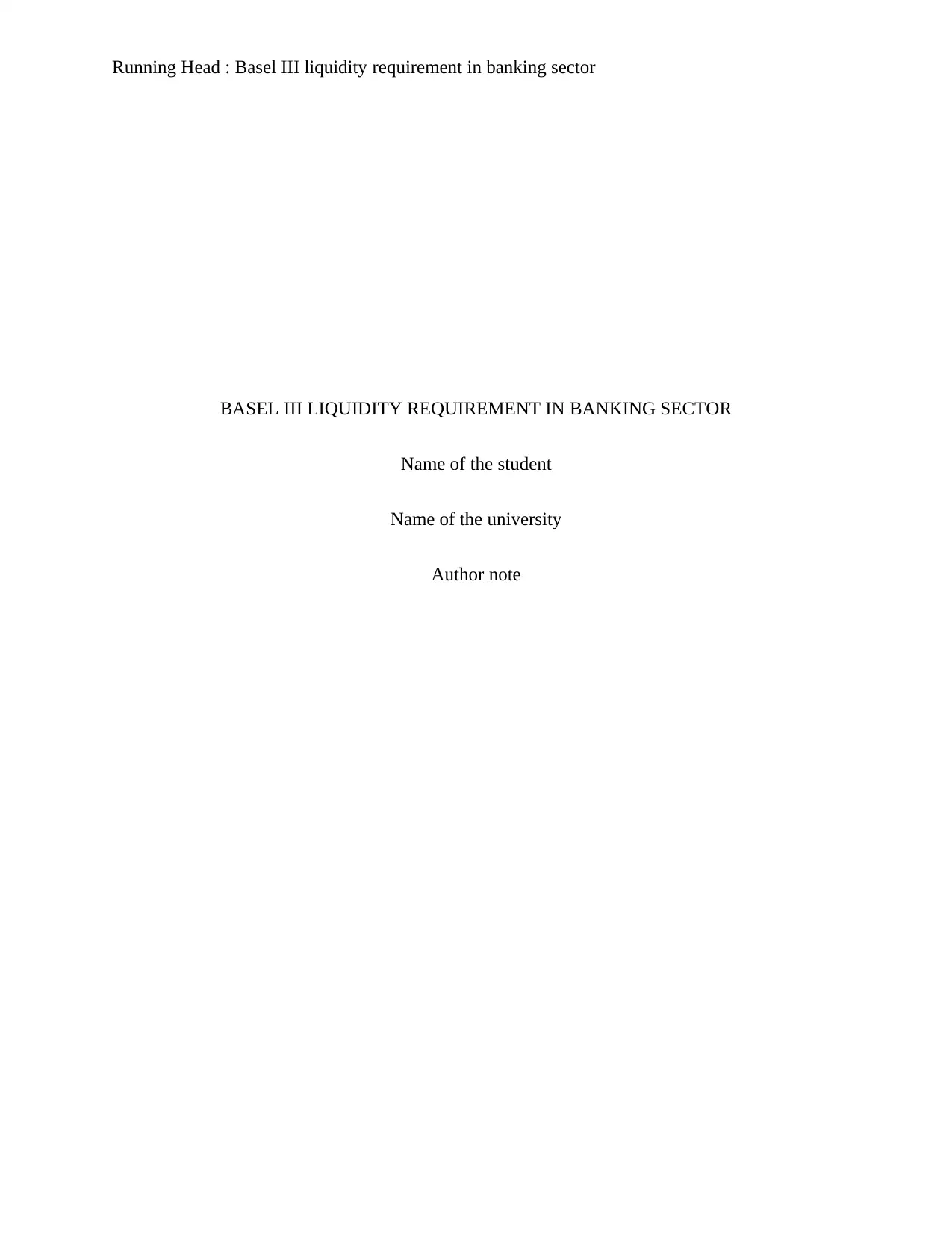
Running Head : Basel III liquidity requirement in banking sector
BASEL III LIQUIDITY REQUIREMENT IN BANKING SECTOR
Name of the student
Name of the university
Author note
BASEL III LIQUIDITY REQUIREMENT IN BANKING SECTOR
Name of the student
Name of the university
Author note
Paraphrase This Document
Need a fresh take? Get an instant paraphrase of this document with our AI Paraphraser
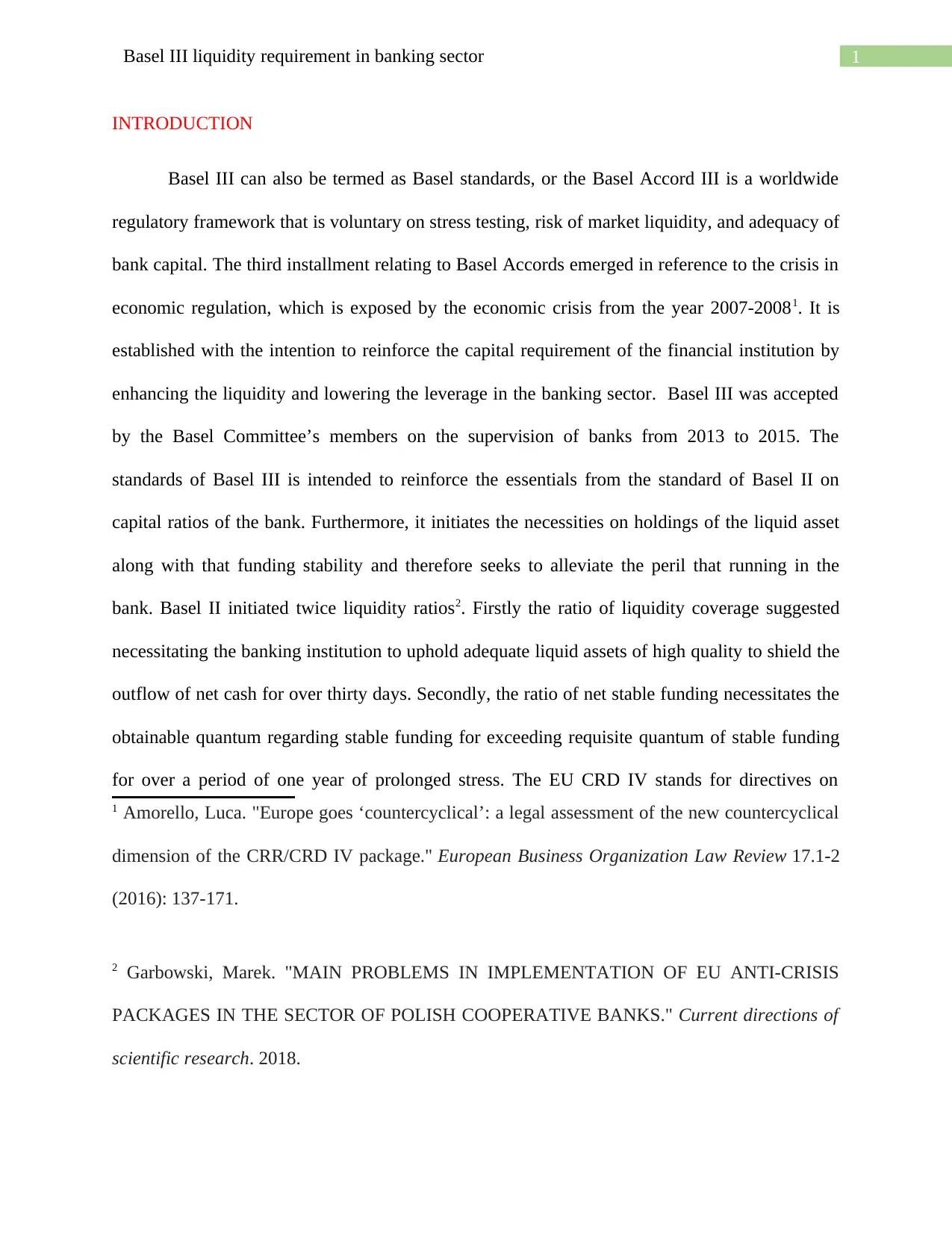
1Basel III liquidity requirement in banking sector
INTRODUCTION
Basel III can also be termed as Basel standards, or the Basel Accord III is a worldwide
regulatory framework that is voluntary on stress testing, risk of market liquidity, and adequacy of
bank capital. The third installment relating to Basel Accords emerged in reference to the crisis in
economic regulation, which is exposed by the economic crisis from the year 2007-20081. It is
established with the intention to reinforce the capital requirement of the financial institution by
enhancing the liquidity and lowering the leverage in the banking sector. Basel III was accepted
by the Basel Committee’s members on the supervision of banks from 2013 to 2015. The
standards of Basel III is intended to reinforce the essentials from the standard of Basel II on
capital ratios of the bank. Furthermore, it initiates the necessities on holdings of the liquid asset
along with that funding stability and therefore seeks to alleviate the peril that running in the
bank. Basel II initiated twice liquidity ratios2. Firstly the ratio of liquidity coverage suggested
necessitating the banking institution to uphold adequate liquid assets of high quality to shield the
outflow of net cash for over thirty days. Secondly, the ratio of net stable funding necessitates the
obtainable quantum regarding stable funding for exceeding requisite quantum of stable funding
for over a period of one year of prolonged stress. The EU CRD IV stands for directives on
1 Amorello, Luca. "Europe goes ‘countercyclical’: a legal assessment of the new countercyclical
dimension of the CRR/CRD IV package." European Business Organization Law Review 17.1-2
(2016): 137-171.
2 Garbowski, Marek. "MAIN PROBLEMS IN IMPLEMENTATION OF EU ANTI-CRISIS
PACKAGES IN THE SECTOR OF POLISH COOPERATIVE BANKS." Current directions of
scientific research. 2018.
INTRODUCTION
Basel III can also be termed as Basel standards, or the Basel Accord III is a worldwide
regulatory framework that is voluntary on stress testing, risk of market liquidity, and adequacy of
bank capital. The third installment relating to Basel Accords emerged in reference to the crisis in
economic regulation, which is exposed by the economic crisis from the year 2007-20081. It is
established with the intention to reinforce the capital requirement of the financial institution by
enhancing the liquidity and lowering the leverage in the banking sector. Basel III was accepted
by the Basel Committee’s members on the supervision of banks from 2013 to 2015. The
standards of Basel III is intended to reinforce the essentials from the standard of Basel II on
capital ratios of the bank. Furthermore, it initiates the necessities on holdings of the liquid asset
along with that funding stability and therefore seeks to alleviate the peril that running in the
bank. Basel II initiated twice liquidity ratios2. Firstly the ratio of liquidity coverage suggested
necessitating the banking institution to uphold adequate liquid assets of high quality to shield the
outflow of net cash for over thirty days. Secondly, the ratio of net stable funding necessitates the
obtainable quantum regarding stable funding for exceeding requisite quantum of stable funding
for over a period of one year of prolonged stress. The EU CRD IV stands for directives on
1 Amorello, Luca. "Europe goes ‘countercyclical’: a legal assessment of the new countercyclical
dimension of the CRR/CRD IV package." European Business Organization Law Review 17.1-2
(2016): 137-171.
2 Garbowski, Marek. "MAIN PROBLEMS IN IMPLEMENTATION OF EU ANTI-CRISIS
PACKAGES IN THE SECTOR OF POLISH COOPERATIVE BANKS." Current directions of
scientific research. 2018.
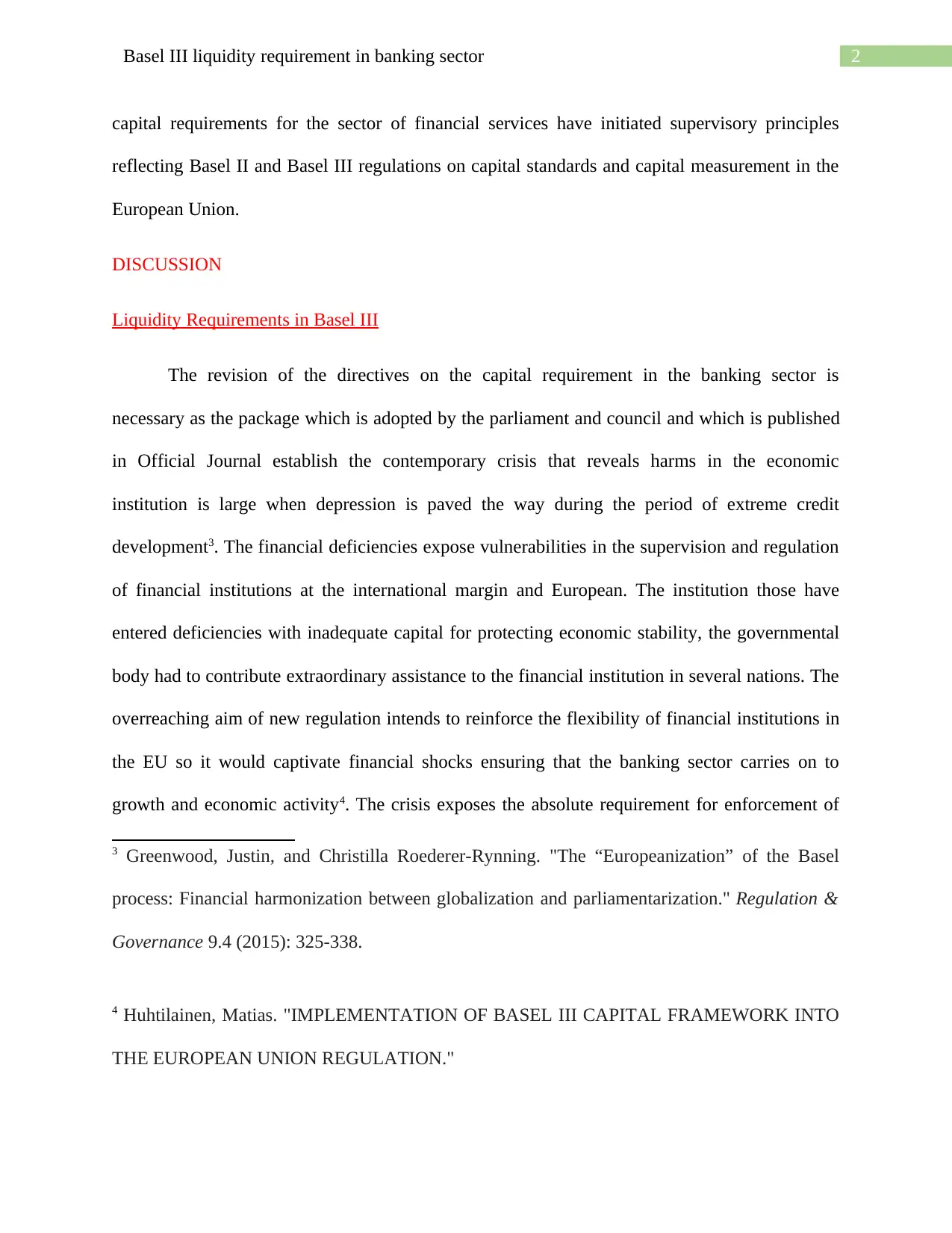
2Basel III liquidity requirement in banking sector
capital requirements for the sector of financial services have initiated supervisory principles
reflecting Basel II and Basel III regulations on capital standards and capital measurement in the
European Union.
DISCUSSION
Liquidity Requirements in Basel III
The revision of the directives on the capital requirement in the banking sector is
necessary as the package which is adopted by the parliament and council and which is published
in Official Journal establish the contemporary crisis that reveals harms in the economic
institution is large when depression is paved the way during the period of extreme credit
development3. The financial deficiencies expose vulnerabilities in the supervision and regulation
of financial institutions at the international margin and European. The institution those have
entered deficiencies with inadequate capital for protecting economic stability, the governmental
body had to contribute extraordinary assistance to the financial institution in several nations. The
overreaching aim of new regulation intends to reinforce the flexibility of financial institutions in
the EU so it would captivate financial shocks ensuring that the banking sector carries on to
growth and economic activity4. The crisis exposes the absolute requirement for enforcement of
3 Greenwood, Justin, and Christilla Roederer‐Rynning. "The “Europeanization” of the Basel
process: Financial harmonization between globalization and parliamentarization." Regulation &
Governance 9.4 (2015): 325-338.
4 Huhtilainen, Matias. "IMPLEMENTATION OF BASEL III CAPITAL FRAMEWORK INTO
THE EUROPEAN UNION REGULATION."
capital requirements for the sector of financial services have initiated supervisory principles
reflecting Basel II and Basel III regulations on capital standards and capital measurement in the
European Union.
DISCUSSION
Liquidity Requirements in Basel III
The revision of the directives on the capital requirement in the banking sector is
necessary as the package which is adopted by the parliament and council and which is published
in Official Journal establish the contemporary crisis that reveals harms in the economic
institution is large when depression is paved the way during the period of extreme credit
development3. The financial deficiencies expose vulnerabilities in the supervision and regulation
of financial institutions at the international margin and European. The institution those have
entered deficiencies with inadequate capital for protecting economic stability, the governmental
body had to contribute extraordinary assistance to the financial institution in several nations. The
overreaching aim of new regulation intends to reinforce the flexibility of financial institutions in
the EU so it would captivate financial shocks ensuring that the banking sector carries on to
growth and economic activity4. The crisis exposes the absolute requirement for enforcement of
3 Greenwood, Justin, and Christilla Roederer‐Rynning. "The “Europeanization” of the Basel
process: Financial harmonization between globalization and parliamentarization." Regulation &
Governance 9.4 (2015): 325-338.
4 Huhtilainen, Matias. "IMPLEMENTATION OF BASEL III CAPITAL FRAMEWORK INTO
THE EUROPEAN UNION REGULATION."
⊘ This is a preview!⊘
Do you want full access?
Subscribe today to unlock all pages.

Trusted by 1+ million students worldwide
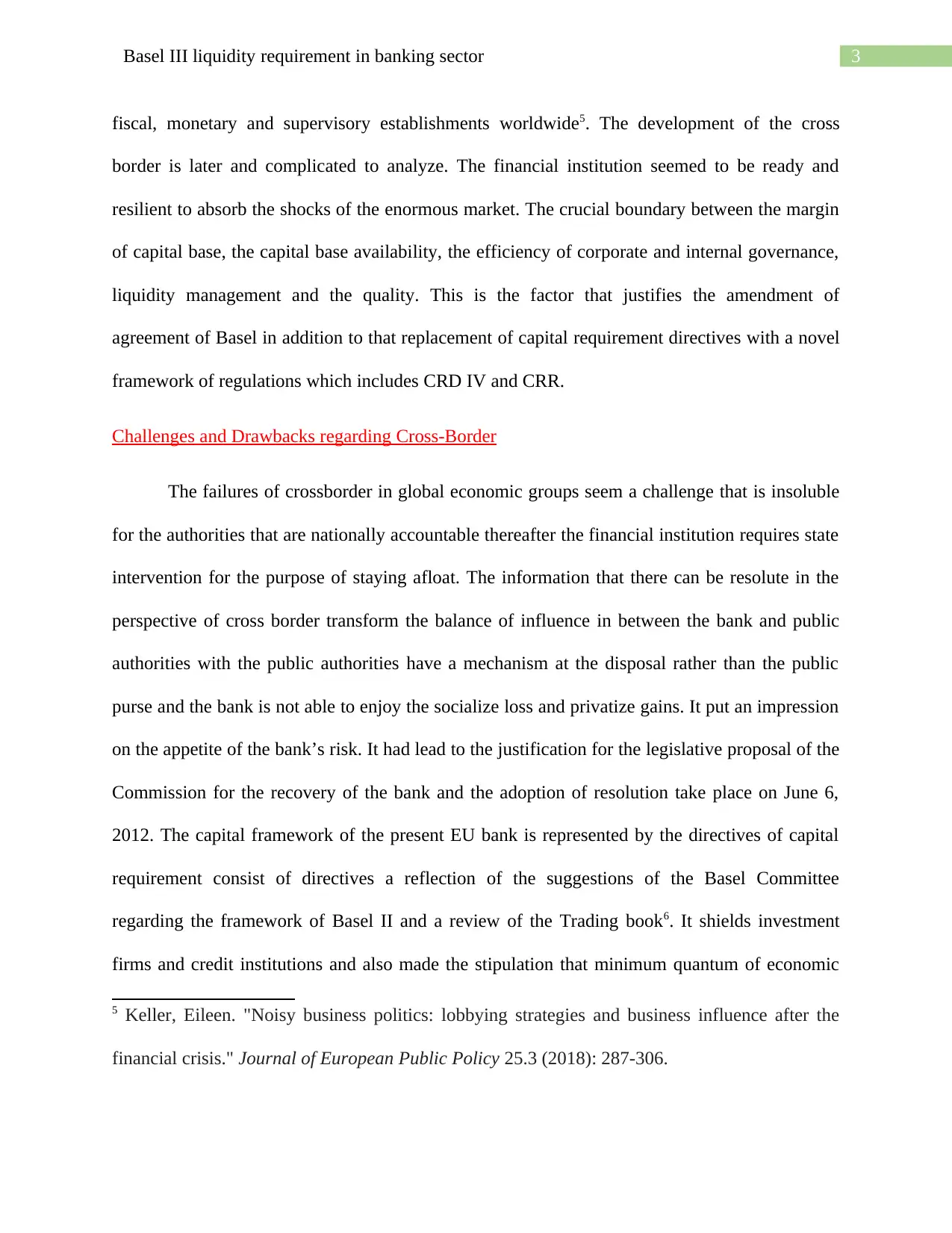
3Basel III liquidity requirement in banking sector
fiscal, monetary and supervisory establishments worldwide5. The development of the cross
border is later and complicated to analyze. The financial institution seemed to be ready and
resilient to absorb the shocks of the enormous market. The crucial boundary between the margin
of capital base, the capital base availability, the efficiency of corporate and internal governance,
liquidity management and the quality. This is the factor that justifies the amendment of
agreement of Basel in addition to that replacement of capital requirement directives with a novel
framework of regulations which includes CRD IV and CRR.
Challenges and Drawbacks regarding Cross-Border
The failures of crossborder in global economic groups seem a challenge that is insoluble
for the authorities that are nationally accountable thereafter the financial institution requires state
intervention for the purpose of staying afloat. The information that there can be resolute in the
perspective of cross border transform the balance of influence in between the bank and public
authorities with the public authorities have a mechanism at the disposal rather than the public
purse and the bank is not able to enjoy the socialize loss and privatize gains. It put an impression
on the appetite of the bank’s risk. It had lead to the justification for the legislative proposal of the
Commission for the recovery of the bank and the adoption of resolution take place on June 6,
2012. The capital framework of the present EU bank is represented by the directives of capital
requirement consist of directives a reflection of the suggestions of the Basel Committee
regarding the framework of Basel II and a review of the Trading book6. It shields investment
firms and credit institutions and also made the stipulation that minimum quantum of economic
5 Keller, Eileen. "Noisy business politics: lobbying strategies and business influence after the
financial crisis." Journal of European Public Policy 25.3 (2018): 287-306.
fiscal, monetary and supervisory establishments worldwide5. The development of the cross
border is later and complicated to analyze. The financial institution seemed to be ready and
resilient to absorb the shocks of the enormous market. The crucial boundary between the margin
of capital base, the capital base availability, the efficiency of corporate and internal governance,
liquidity management and the quality. This is the factor that justifies the amendment of
agreement of Basel in addition to that replacement of capital requirement directives with a novel
framework of regulations which includes CRD IV and CRR.
Challenges and Drawbacks regarding Cross-Border
The failures of crossborder in global economic groups seem a challenge that is insoluble
for the authorities that are nationally accountable thereafter the financial institution requires state
intervention for the purpose of staying afloat. The information that there can be resolute in the
perspective of cross border transform the balance of influence in between the bank and public
authorities with the public authorities have a mechanism at the disposal rather than the public
purse and the bank is not able to enjoy the socialize loss and privatize gains. It put an impression
on the appetite of the bank’s risk. It had lead to the justification for the legislative proposal of the
Commission for the recovery of the bank and the adoption of resolution take place on June 6,
2012. The capital framework of the present EU bank is represented by the directives of capital
requirement consist of directives a reflection of the suggestions of the Basel Committee
regarding the framework of Basel II and a review of the Trading book6. It shields investment
firms and credit institutions and also made the stipulation that minimum quantum of economic
5 Keller, Eileen. "Noisy business politics: lobbying strategies and business influence after the
financial crisis." Journal of European Public Policy 25.3 (2018): 287-306.
Paraphrase This Document
Need a fresh take? Get an instant paraphrase of this document with our AI Paraphraser
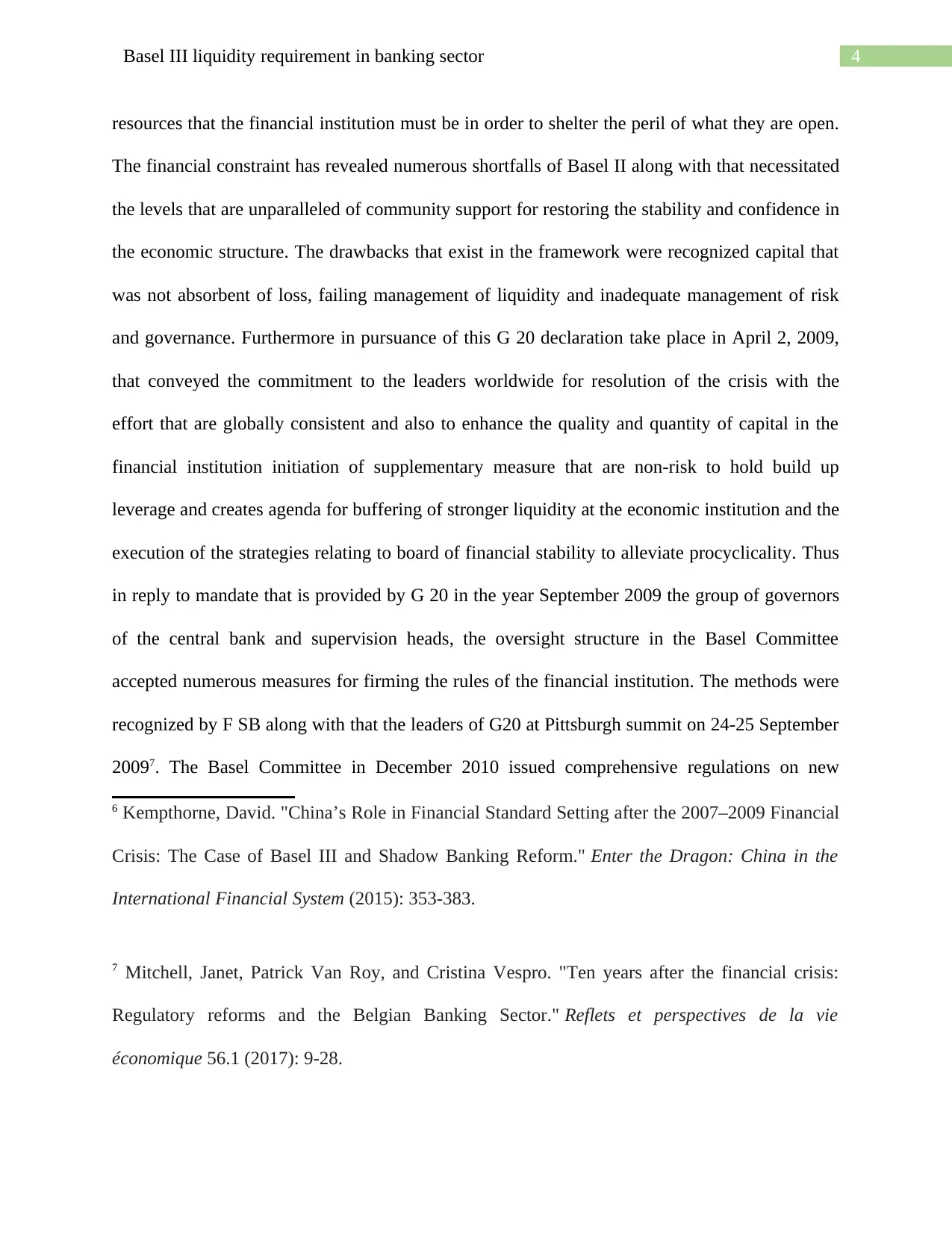
4Basel III liquidity requirement in banking sector
resources that the financial institution must be in order to shelter the peril of what they are open.
The financial constraint has revealed numerous shortfalls of Basel II along with that necessitated
the levels that are unparalleled of community support for restoring the stability and confidence in
the economic structure. The drawbacks that exist in the framework were recognized capital that
was not absorbent of loss, failing management of liquidity and inadequate management of risk
and governance. Furthermore in pursuance of this G 20 declaration take place in April 2, 2009,
that conveyed the commitment to the leaders worldwide for resolution of the crisis with the
effort that are globally consistent and also to enhance the quality and quantity of capital in the
financial institution initiation of supplementary measure that are non-risk to hold build up
leverage and creates agenda for buffering of stronger liquidity at the economic institution and the
execution of the strategies relating to board of financial stability to alleviate procyclicality. Thus
in reply to mandate that is provided by G 20 in the year September 2009 the group of governors
of the central bank and supervision heads, the oversight structure in the Basel Committee
accepted numerous measures for firming the rules of the financial institution. The methods were
recognized by F SB along with that the leaders of G20 at Pittsburgh summit on 24-25 September
20097. The Basel Committee in December 2010 issued comprehensive regulations on new
6 Kempthorne, David. "China’s Role in Financial Standard Setting after the 2007–2009 Financial
Crisis: The Case of Basel III and Shadow Banking Reform." Enter the Dragon: China in the
International Financial System (2015): 353-383.
7 Mitchell, Janet, Patrick Van Roy, and Cristina Vespro. "Ten years after the financial crisis:
Regulatory reforms and the Belgian Banking Sector." Reflets et perspectives de la vie
économique 56.1 (2017): 9-28.
resources that the financial institution must be in order to shelter the peril of what they are open.
The financial constraint has revealed numerous shortfalls of Basel II along with that necessitated
the levels that are unparalleled of community support for restoring the stability and confidence in
the economic structure. The drawbacks that exist in the framework were recognized capital that
was not absorbent of loss, failing management of liquidity and inadequate management of risk
and governance. Furthermore in pursuance of this G 20 declaration take place in April 2, 2009,
that conveyed the commitment to the leaders worldwide for resolution of the crisis with the
effort that are globally consistent and also to enhance the quality and quantity of capital in the
financial institution initiation of supplementary measure that are non-risk to hold build up
leverage and creates agenda for buffering of stronger liquidity at the economic institution and the
execution of the strategies relating to board of financial stability to alleviate procyclicality. Thus
in reply to mandate that is provided by G 20 in the year September 2009 the group of governors
of the central bank and supervision heads, the oversight structure in the Basel Committee
accepted numerous measures for firming the rules of the financial institution. The methods were
recognized by F SB along with that the leaders of G20 at Pittsburgh summit on 24-25 September
20097. The Basel Committee in December 2010 issued comprehensive regulations on new
6 Kempthorne, David. "China’s Role in Financial Standard Setting after the 2007–2009 Financial
Crisis: The Case of Basel III and Shadow Banking Reform." Enter the Dragon: China in the
International Financial System (2015): 353-383.
7 Mitchell, Janet, Patrick Van Roy, and Cristina Vespro. "Ten years after the financial crisis:
Regulatory reforms and the Belgian Banking Sector." Reflets et perspectives de la vie
économique 56.1 (2017): 9-28.

5Basel III liquidity requirement in banking sector
international standards of regulations on the capital adequacy of financial institutions and
liquidity that are referred collectively as Basel III.
Relevancy of the Standards
The Basel Committee on the supervision of the banking sector has charge of the
development of standards that are international on the adequacy of bank capital. It rests on bank
headquarters for global settlement in Switzerland, Basel. The Basel formulates minimum
principles on the adequacy of bank capital. The Basel committee owing to financial emergencies,
reconsider the standards of capital adequacy. Basel III is the consequence of the examination is
the third form of the standards. The structure of Basel III in the financial sector proposed to
strengthen the bank. Firstly more and better capital that is bank having a capital base on the
meeting of the balance sheet the regulatory principles turned out not available when requiring the
absorption of loss. The criteria prescribed by Basel III that met by the instruments of funds to
guaranteeing that they efficiently engross the losses of the bank at the moment of stress. The
major difficulty was the deficiency of liquid funding and liquid assets at the time of crisis are
referred to as dried up of the market. It is required by Basel III that the bankers need to manage
liquidity and cash flows in more intense manner in comparison to before and prediction of
liquidity flows resulting in claims of the creditor improved than before along with that ready for
marker situations that are stressed by having availability of adequate capital both in long term
and short term. Thirdly leverage backstop the measured risk weigh of Basel 2.5 and 2 comprises
of faults and defects or new models that developed along with that risk weigh are not assessed
precisely the mechanism of conventional backstop restrict the development of balance sheet in
international standards of regulations on the capital adequacy of financial institutions and
liquidity that are referred collectively as Basel III.
Relevancy of the Standards
The Basel Committee on the supervision of the banking sector has charge of the
development of standards that are international on the adequacy of bank capital. It rests on bank
headquarters for global settlement in Switzerland, Basel. The Basel formulates minimum
principles on the adequacy of bank capital. The Basel committee owing to financial emergencies,
reconsider the standards of capital adequacy. Basel III is the consequence of the examination is
the third form of the standards. The structure of Basel III in the financial sector proposed to
strengthen the bank. Firstly more and better capital that is bank having a capital base on the
meeting of the balance sheet the regulatory principles turned out not available when requiring the
absorption of loss. The criteria prescribed by Basel III that met by the instruments of funds to
guaranteeing that they efficiently engross the losses of the bank at the moment of stress. The
major difficulty was the deficiency of liquid funding and liquid assets at the time of crisis are
referred to as dried up of the market. It is required by Basel III that the bankers need to manage
liquidity and cash flows in more intense manner in comparison to before and prediction of
liquidity flows resulting in claims of the creditor improved than before along with that ready for
marker situations that are stressed by having availability of adequate capital both in long term
and short term. Thirdly leverage backstop the measured risk weigh of Basel 2.5 and 2 comprises
of faults and defects or new models that developed along with that risk weigh are not assessed
precisely the mechanism of conventional backstop restrict the development of balance sheet in
⊘ This is a preview!⊘
Do you want full access?
Subscribe today to unlock all pages.

Trusted by 1+ million students worldwide
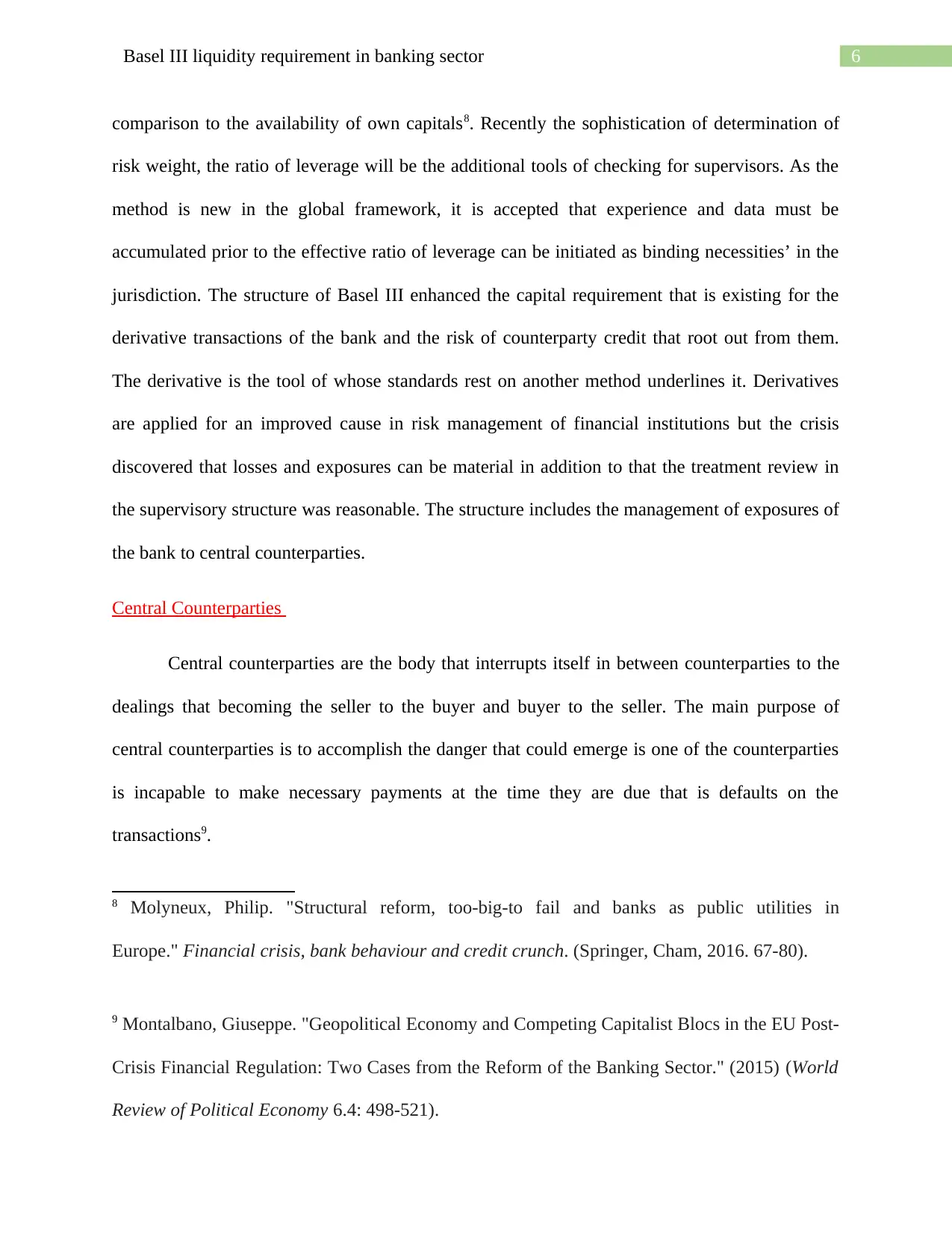
6Basel III liquidity requirement in banking sector
comparison to the availability of own capitals8. Recently the sophistication of determination of
risk weight, the ratio of leverage will be the additional tools of checking for supervisors. As the
method is new in the global framework, it is accepted that experience and data must be
accumulated prior to the effective ratio of leverage can be initiated as binding necessities’ in the
jurisdiction. The structure of Basel III enhanced the capital requirement that is existing for the
derivative transactions of the bank and the risk of counterparty credit that root out from them.
The derivative is the tool of whose standards rest on another method underlines it. Derivatives
are applied for an improved cause in risk management of financial institutions but the crisis
discovered that losses and exposures can be material in addition to that the treatment review in
the supervisory structure was reasonable. The structure includes the management of exposures of
the bank to central counterparties.
Central Counterparties
Central counterparties are the body that interrupts itself in between counterparties to the
dealings that becoming the seller to the buyer and buyer to the seller. The main purpose of
central counterparties is to accomplish the danger that could emerge is one of the counterparties
is incapable to make necessary payments at the time they are due that is defaults on the
transactions9.
8 Molyneux, Philip. "Structural reform, too-big-to fail and banks as public utilities in
Europe." Financial crisis, bank behaviour and credit crunch. (Springer, Cham, 2016. 67-80).
9 Montalbano, Giuseppe. "Geopolitical Economy and Competing Capitalist Blocs in the EU Post-
Crisis Financial Regulation: Two Cases from the Reform of the Banking Sector." (2015) (World
Review of Political Economy 6.4: 498-521).
comparison to the availability of own capitals8. Recently the sophistication of determination of
risk weight, the ratio of leverage will be the additional tools of checking for supervisors. As the
method is new in the global framework, it is accepted that experience and data must be
accumulated prior to the effective ratio of leverage can be initiated as binding necessities’ in the
jurisdiction. The structure of Basel III enhanced the capital requirement that is existing for the
derivative transactions of the bank and the risk of counterparty credit that root out from them.
The derivative is the tool of whose standards rest on another method underlines it. Derivatives
are applied for an improved cause in risk management of financial institutions but the crisis
discovered that losses and exposures can be material in addition to that the treatment review in
the supervisory structure was reasonable. The structure includes the management of exposures of
the bank to central counterparties.
Central Counterparties
Central counterparties are the body that interrupts itself in between counterparties to the
dealings that becoming the seller to the buyer and buyer to the seller. The main purpose of
central counterparties is to accomplish the danger that could emerge is one of the counterparties
is incapable to make necessary payments at the time they are due that is defaults on the
transactions9.
8 Molyneux, Philip. "Structural reform, too-big-to fail and banks as public utilities in
Europe." Financial crisis, bank behaviour and credit crunch. (Springer, Cham, 2016. 67-80).
9 Montalbano, Giuseppe. "Geopolitical Economy and Competing Capitalist Blocs in the EU Post-
Crisis Financial Regulation: Two Cases from the Reform of the Banking Sector." (2015) (World
Review of Political Economy 6.4: 498-521).
Paraphrase This Document
Need a fresh take? Get an instant paraphrase of this document with our AI Paraphraser
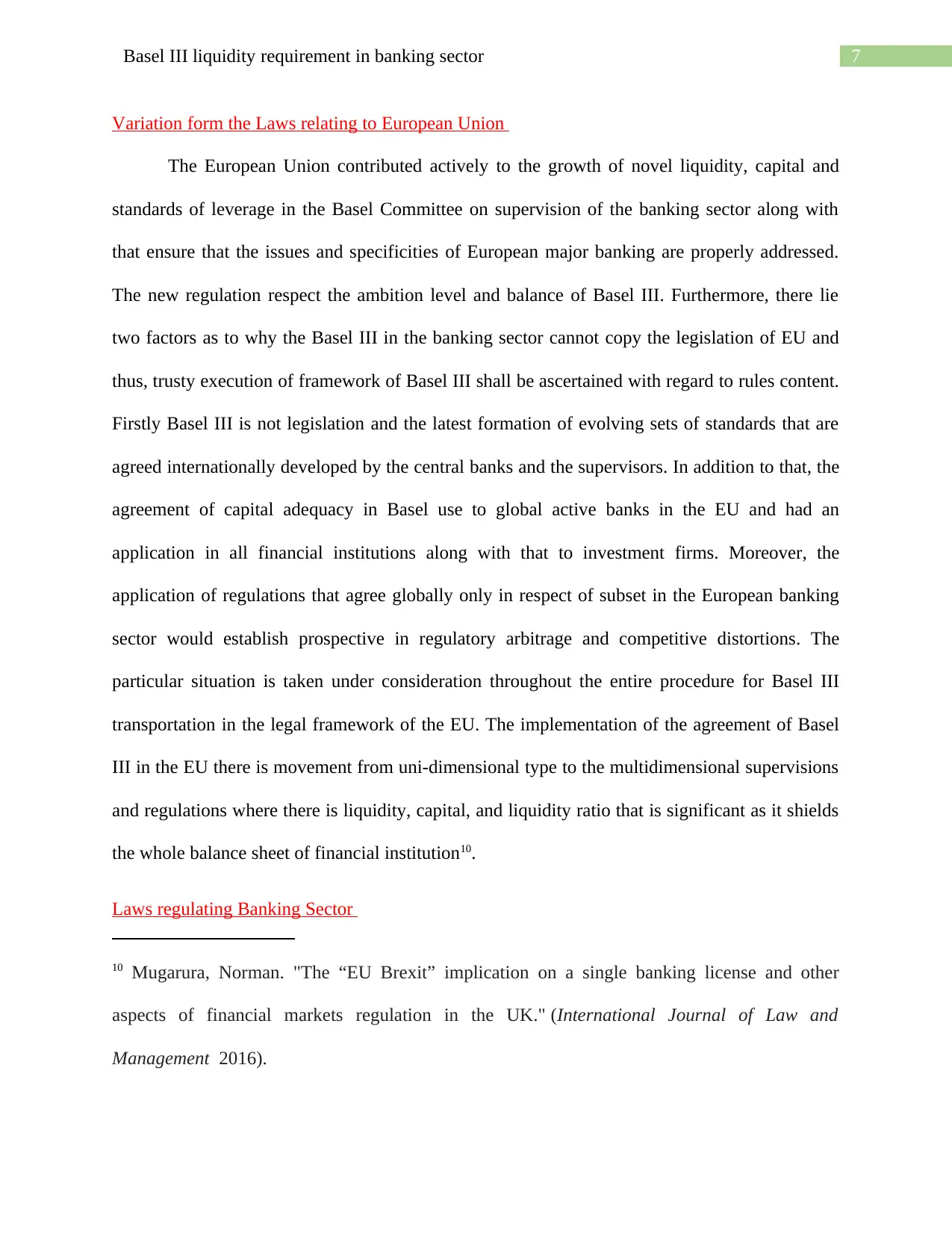
7Basel III liquidity requirement in banking sector
Variation form the Laws relating to European Union
The European Union contributed actively to the growth of novel liquidity, capital and
standards of leverage in the Basel Committee on supervision of the banking sector along with
that ensure that the issues and specificities of European major banking are properly addressed.
The new regulation respect the ambition level and balance of Basel III. Furthermore, there lie
two factors as to why the Basel III in the banking sector cannot copy the legislation of EU and
thus, trusty execution of framework of Basel III shall be ascertained with regard to rules content.
Firstly Basel III is not legislation and the latest formation of evolving sets of standards that are
agreed internationally developed by the central banks and the supervisors. In addition to that, the
agreement of capital adequacy in Basel use to global active banks in the EU and had an
application in all financial institutions along with that to investment firms. Moreover, the
application of regulations that agree globally only in respect of subset in the European banking
sector would establish prospective in regulatory arbitrage and competitive distortions. The
particular situation is taken under consideration throughout the entire procedure for Basel III
transportation in the legal framework of the EU. The implementation of the agreement of Basel
III in the EU there is movement from uni-dimensional type to the multidimensional supervisions
and regulations where there is liquidity, capital, and liquidity ratio that is significant as it shields
the whole balance sheet of financial institution10.
Laws regulating Banking Sector
10 Mugarura, Norman. "The “EU Brexit” implication on a single banking license and other
aspects of financial markets regulation in the UK." (International Journal of Law and
Management 2016).
Variation form the Laws relating to European Union
The European Union contributed actively to the growth of novel liquidity, capital and
standards of leverage in the Basel Committee on supervision of the banking sector along with
that ensure that the issues and specificities of European major banking are properly addressed.
The new regulation respect the ambition level and balance of Basel III. Furthermore, there lie
two factors as to why the Basel III in the banking sector cannot copy the legislation of EU and
thus, trusty execution of framework of Basel III shall be ascertained with regard to rules content.
Firstly Basel III is not legislation and the latest formation of evolving sets of standards that are
agreed internationally developed by the central banks and the supervisors. In addition to that, the
agreement of capital adequacy in Basel use to global active banks in the EU and had an
application in all financial institutions along with that to investment firms. Moreover, the
application of regulations that agree globally only in respect of subset in the European banking
sector would establish prospective in regulatory arbitrage and competitive distortions. The
particular situation is taken under consideration throughout the entire procedure for Basel III
transportation in the legal framework of the EU. The implementation of the agreement of Basel
III in the EU there is movement from uni-dimensional type to the multidimensional supervisions
and regulations where there is liquidity, capital, and liquidity ratio that is significant as it shields
the whole balance sheet of financial institution10.
Laws regulating Banking Sector
10 Mugarura, Norman. "The “EU Brexit” implication on a single banking license and other
aspects of financial markets regulation in the UK." (International Journal of Law and
Management 2016).
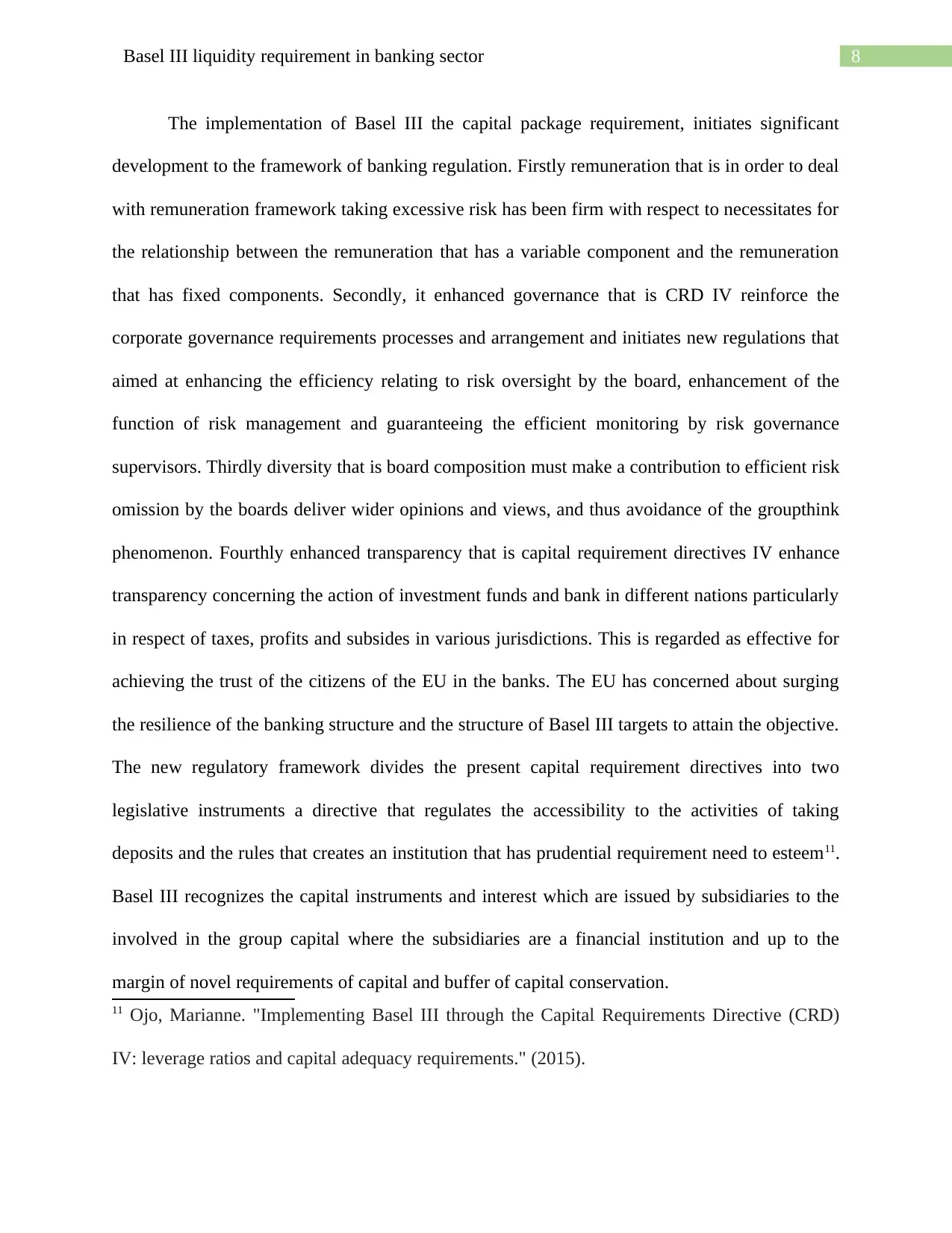
8Basel III liquidity requirement in banking sector
The implementation of Basel III the capital package requirement, initiates significant
development to the framework of banking regulation. Firstly remuneration that is in order to deal
with remuneration framework taking excessive risk has been firm with respect to necessitates for
the relationship between the remuneration that has a variable component and the remuneration
that has fixed components. Secondly, it enhanced governance that is CRD IV reinforce the
corporate governance requirements processes and arrangement and initiates new regulations that
aimed at enhancing the efficiency relating to risk oversight by the board, enhancement of the
function of risk management and guaranteeing the efficient monitoring by risk governance
supervisors. Thirdly diversity that is board composition must make a contribution to efficient risk
omission by the boards deliver wider opinions and views, and thus avoidance of the groupthink
phenomenon. Fourthly enhanced transparency that is capital requirement directives IV enhance
transparency concerning the action of investment funds and bank in different nations particularly
in respect of taxes, profits and subsides in various jurisdictions. This is regarded as effective for
achieving the trust of the citizens of the EU in the banks. The EU has concerned about surging
the resilience of the banking structure and the structure of Basel III targets to attain the objective.
The new regulatory framework divides the present capital requirement directives into two
legislative instruments a directive that regulates the accessibility to the activities of taking
deposits and the rules that creates an institution that has prudential requirement need to esteem11.
Basel III recognizes the capital instruments and interest which are issued by subsidiaries to the
involved in the group capital where the subsidiaries are a financial institution and up to the
margin of novel requirements of capital and buffer of capital conservation.
11 Ojo, Marianne. "Implementing Basel III through the Capital Requirements Directive (CRD)
IV: leverage ratios and capital adequacy requirements." (2015).
The implementation of Basel III the capital package requirement, initiates significant
development to the framework of banking regulation. Firstly remuneration that is in order to deal
with remuneration framework taking excessive risk has been firm with respect to necessitates for
the relationship between the remuneration that has a variable component and the remuneration
that has fixed components. Secondly, it enhanced governance that is CRD IV reinforce the
corporate governance requirements processes and arrangement and initiates new regulations that
aimed at enhancing the efficiency relating to risk oversight by the board, enhancement of the
function of risk management and guaranteeing the efficient monitoring by risk governance
supervisors. Thirdly diversity that is board composition must make a contribution to efficient risk
omission by the boards deliver wider opinions and views, and thus avoidance of the groupthink
phenomenon. Fourthly enhanced transparency that is capital requirement directives IV enhance
transparency concerning the action of investment funds and bank in different nations particularly
in respect of taxes, profits and subsides in various jurisdictions. This is regarded as effective for
achieving the trust of the citizens of the EU in the banks. The EU has concerned about surging
the resilience of the banking structure and the structure of Basel III targets to attain the objective.
The new regulatory framework divides the present capital requirement directives into two
legislative instruments a directive that regulates the accessibility to the activities of taking
deposits and the rules that creates an institution that has prudential requirement need to esteem11.
Basel III recognizes the capital instruments and interest which are issued by subsidiaries to the
involved in the group capital where the subsidiaries are a financial institution and up to the
margin of novel requirements of capital and buffer of capital conservation.
11 Ojo, Marianne. "Implementing Basel III through the Capital Requirements Directive (CRD)
IV: leverage ratios and capital adequacy requirements." (2015).
⊘ This is a preview!⊘
Do you want full access?
Subscribe today to unlock all pages.

Trusted by 1+ million students worldwide
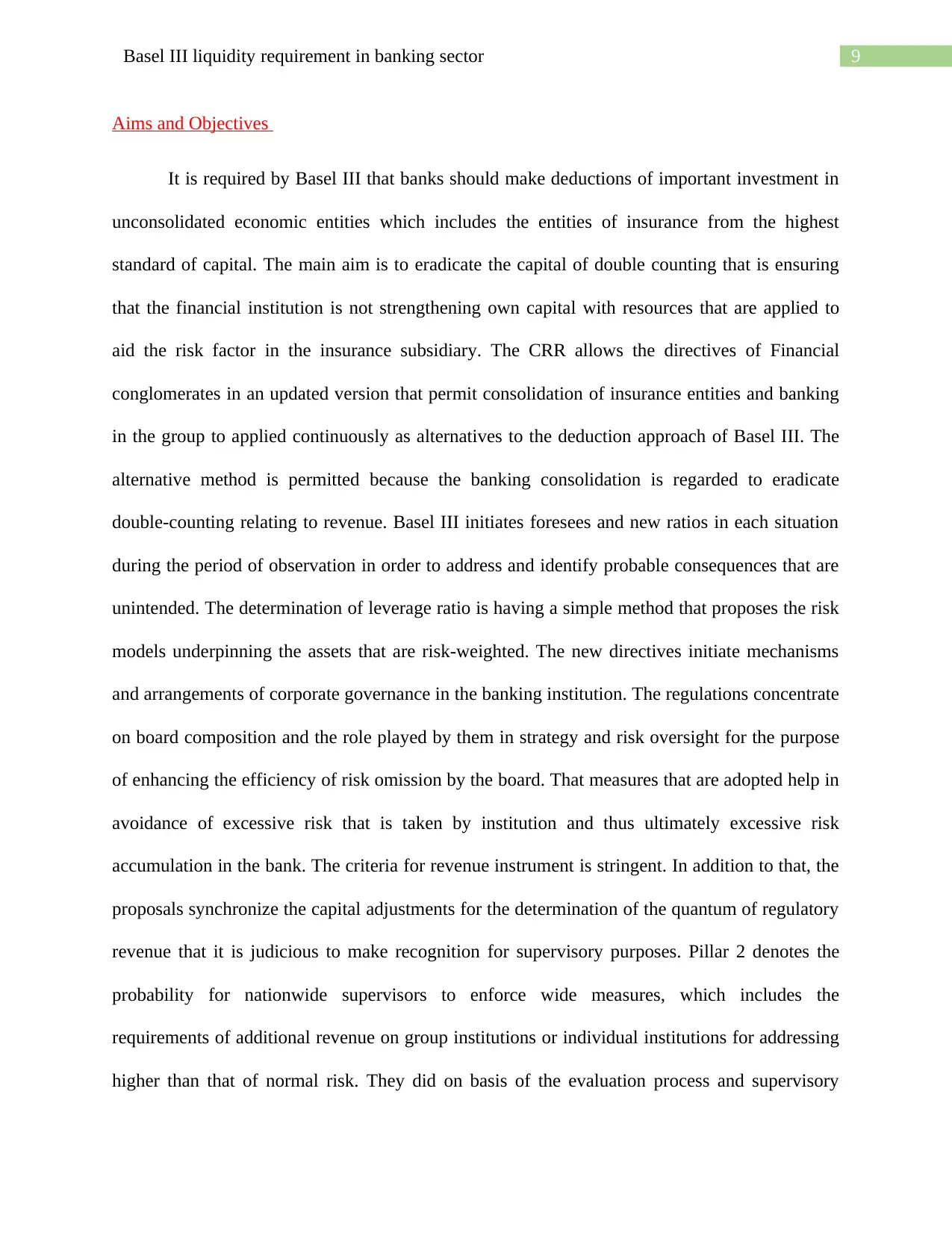
9Basel III liquidity requirement in banking sector
Aims and Objectives
It is required by Basel III that banks should make deductions of important investment in
unconsolidated economic entities which includes the entities of insurance from the highest
standard of capital. The main aim is to eradicate the capital of double counting that is ensuring
that the financial institution is not strengthening own capital with resources that are applied to
aid the risk factor in the insurance subsidiary. The CRR allows the directives of Financial
conglomerates in an updated version that permit consolidation of insurance entities and banking
in the group to applied continuously as alternatives to the deduction approach of Basel III. The
alternative method is permitted because the banking consolidation is regarded to eradicate
double-counting relating to revenue. Basel III initiates foresees and new ratios in each situation
during the period of observation in order to address and identify probable consequences that are
unintended. The determination of leverage ratio is having a simple method that proposes the risk
models underpinning the assets that are risk-weighted. The new directives initiate mechanisms
and arrangements of corporate governance in the banking institution. The regulations concentrate
on board composition and the role played by them in strategy and risk oversight for the purpose
of enhancing the efficiency of risk omission by the board. That measures that are adopted help in
avoidance of excessive risk that is taken by institution and thus ultimately excessive risk
accumulation in the bank. The criteria for revenue instrument is stringent. In addition to that, the
proposals synchronize the capital adjustments for the determination of the quantum of regulatory
revenue that it is judicious to make recognition for supervisory purposes. Pillar 2 denotes the
probability for nationwide supervisors to enforce wide measures, which includes the
requirements of additional revenue on group institutions or individual institutions for addressing
higher than that of normal risk. They did on basis of the evaluation process and supervisory
Aims and Objectives
It is required by Basel III that banks should make deductions of important investment in
unconsolidated economic entities which includes the entities of insurance from the highest
standard of capital. The main aim is to eradicate the capital of double counting that is ensuring
that the financial institution is not strengthening own capital with resources that are applied to
aid the risk factor in the insurance subsidiary. The CRR allows the directives of Financial
conglomerates in an updated version that permit consolidation of insurance entities and banking
in the group to applied continuously as alternatives to the deduction approach of Basel III. The
alternative method is permitted because the banking consolidation is regarded to eradicate
double-counting relating to revenue. Basel III initiates foresees and new ratios in each situation
during the period of observation in order to address and identify probable consequences that are
unintended. The determination of leverage ratio is having a simple method that proposes the risk
models underpinning the assets that are risk-weighted. The new directives initiate mechanisms
and arrangements of corporate governance in the banking institution. The regulations concentrate
on board composition and the role played by them in strategy and risk oversight for the purpose
of enhancing the efficiency of risk omission by the board. That measures that are adopted help in
avoidance of excessive risk that is taken by institution and thus ultimately excessive risk
accumulation in the bank. The criteria for revenue instrument is stringent. In addition to that, the
proposals synchronize the capital adjustments for the determination of the quantum of regulatory
revenue that it is judicious to make recognition for supervisory purposes. Pillar 2 denotes the
probability for nationwide supervisors to enforce wide measures, which includes the
requirements of additional revenue on group institutions or individual institutions for addressing
higher than that of normal risk. They did on basis of the evaluation process and supervisory
Paraphrase This Document
Need a fresh take? Get an instant paraphrase of this document with our AI Paraphraser
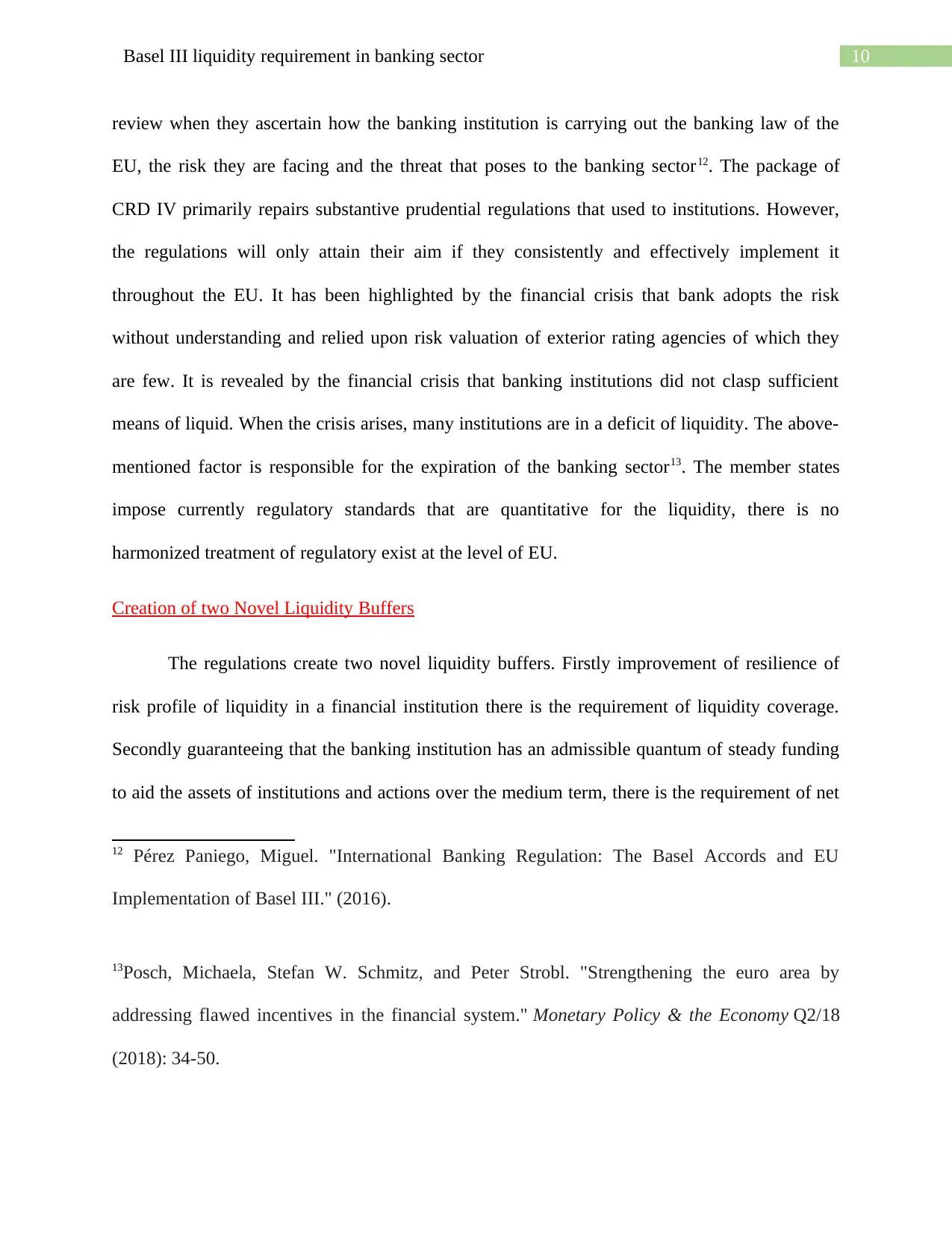
10Basel III liquidity requirement in banking sector
review when they ascertain how the banking institution is carrying out the banking law of the
EU, the risk they are facing and the threat that poses to the banking sector12. The package of
CRD IV primarily repairs substantive prudential regulations that used to institutions. However,
the regulations will only attain their aim if they consistently and effectively implement it
throughout the EU. It has been highlighted by the financial crisis that bank adopts the risk
without understanding and relied upon risk valuation of exterior rating agencies of which they
are few. It is revealed by the financial crisis that banking institutions did not clasp sufficient
means of liquid. When the crisis arises, many institutions are in a deficit of liquidity. The above-
mentioned factor is responsible for the expiration of the banking sector13. The member states
impose currently regulatory standards that are quantitative for the liquidity, there is no
harmonized treatment of regulatory exist at the level of EU.
Creation of two Novel Liquidity Buffers
The regulations create two novel liquidity buffers. Firstly improvement of resilience of
risk profile of liquidity in a financial institution there is the requirement of liquidity coverage.
Secondly guaranteeing that the banking institution has an admissible quantum of steady funding
to aid the assets of institutions and actions over the medium term, there is the requirement of net
12 Pérez Paniego, Miguel. "International Banking Regulation: The Basel Accords and EU
Implementation of Basel III." (2016).
13Posch, Michaela, Stefan W. Schmitz, and Peter Strobl. "Strengthening the euro area by
addressing flawed incentives in the financial system." Monetary Policy & the Economy Q2/18
(2018): 34-50.
review when they ascertain how the banking institution is carrying out the banking law of the
EU, the risk they are facing and the threat that poses to the banking sector12. The package of
CRD IV primarily repairs substantive prudential regulations that used to institutions. However,
the regulations will only attain their aim if they consistently and effectively implement it
throughout the EU. It has been highlighted by the financial crisis that bank adopts the risk
without understanding and relied upon risk valuation of exterior rating agencies of which they
are few. It is revealed by the financial crisis that banking institutions did not clasp sufficient
means of liquid. When the crisis arises, many institutions are in a deficit of liquidity. The above-
mentioned factor is responsible for the expiration of the banking sector13. The member states
impose currently regulatory standards that are quantitative for the liquidity, there is no
harmonized treatment of regulatory exist at the level of EU.
Creation of two Novel Liquidity Buffers
The regulations create two novel liquidity buffers. Firstly improvement of resilience of
risk profile of liquidity in a financial institution there is the requirement of liquidity coverage.
Secondly guaranteeing that the banking institution has an admissible quantum of steady funding
to aid the assets of institutions and actions over the medium term, there is the requirement of net
12 Pérez Paniego, Miguel. "International Banking Regulation: The Basel Accords and EU
Implementation of Basel III." (2016).
13Posch, Michaela, Stefan W. Schmitz, and Peter Strobl. "Strengthening the euro area by
addressing flawed incentives in the financial system." Monetary Policy & the Economy Q2/18
(2018): 34-50.
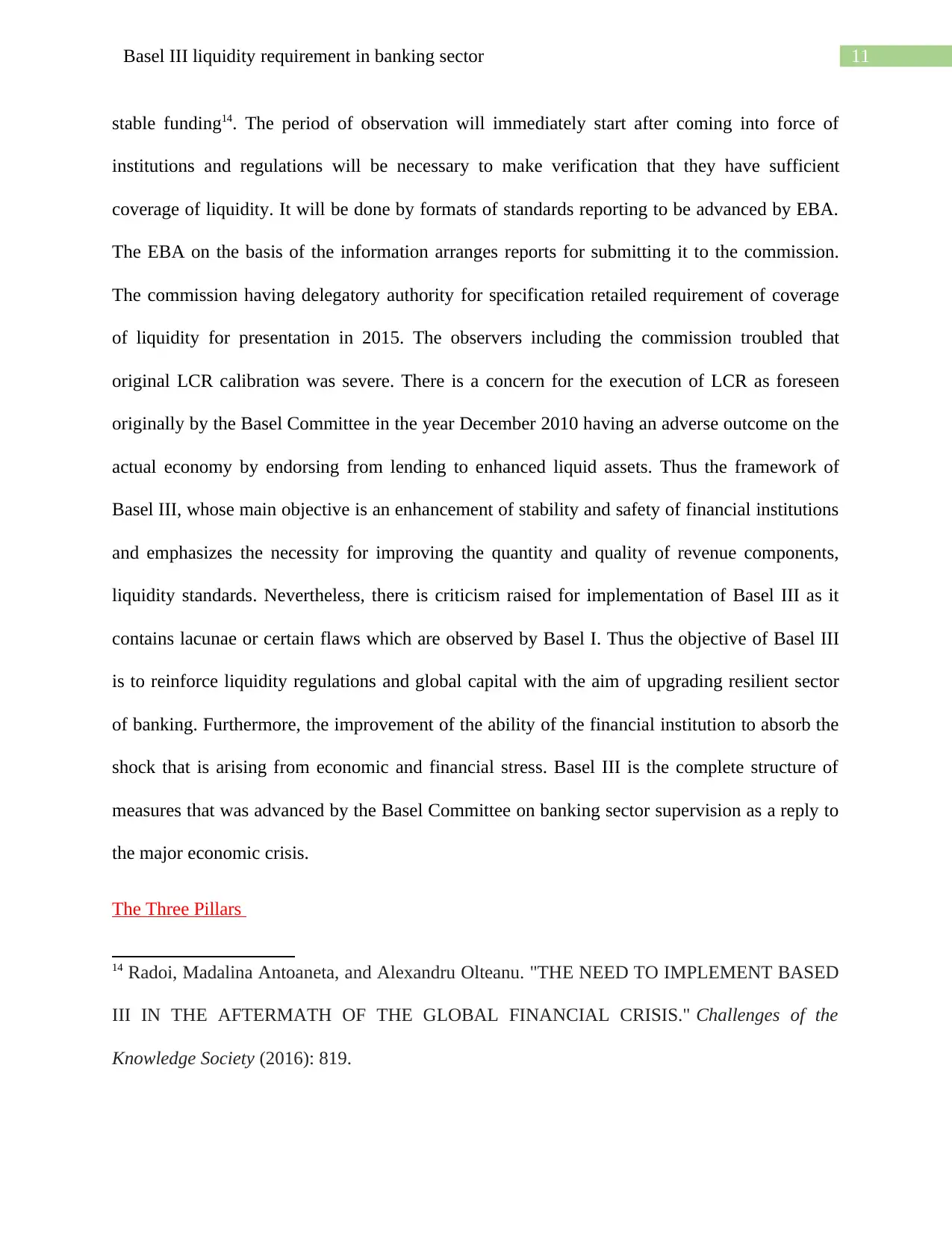
11Basel III liquidity requirement in banking sector
stable funding14. The period of observation will immediately start after coming into force of
institutions and regulations will be necessary to make verification that they have sufficient
coverage of liquidity. It will be done by formats of standards reporting to be advanced by EBA.
The EBA on the basis of the information arranges reports for submitting it to the commission.
The commission having delegatory authority for specification retailed requirement of coverage
of liquidity for presentation in 2015. The observers including the commission troubled that
original LCR calibration was severe. There is a concern for the execution of LCR as foreseen
originally by the Basel Committee in the year December 2010 having an adverse outcome on the
actual economy by endorsing from lending to enhanced liquid assets. Thus the framework of
Basel III, whose main objective is an enhancement of stability and safety of financial institutions
and emphasizes the necessity for improving the quantity and quality of revenue components,
liquidity standards. Nevertheless, there is criticism raised for implementation of Basel III as it
contains lacunae or certain flaws which are observed by Basel I. Thus the objective of Basel III
is to reinforce liquidity regulations and global capital with the aim of upgrading resilient sector
of banking. Furthermore, the improvement of the ability of the financial institution to absorb the
shock that is arising from economic and financial stress. Basel III is the complete structure of
measures that was advanced by the Basel Committee on banking sector supervision as a reply to
the major economic crisis.
The Three Pillars
14 Radoi, Madalina Antoaneta, and Alexandru Olteanu. "THE NEED TO IMPLEMENT BASED
III IN THE AFTERMATH OF THE GLOBAL FINANCIAL CRISIS." Challenges of the
Knowledge Society (2016): 819.
stable funding14. The period of observation will immediately start after coming into force of
institutions and regulations will be necessary to make verification that they have sufficient
coverage of liquidity. It will be done by formats of standards reporting to be advanced by EBA.
The EBA on the basis of the information arranges reports for submitting it to the commission.
The commission having delegatory authority for specification retailed requirement of coverage
of liquidity for presentation in 2015. The observers including the commission troubled that
original LCR calibration was severe. There is a concern for the execution of LCR as foreseen
originally by the Basel Committee in the year December 2010 having an adverse outcome on the
actual economy by endorsing from lending to enhanced liquid assets. Thus the framework of
Basel III, whose main objective is an enhancement of stability and safety of financial institutions
and emphasizes the necessity for improving the quantity and quality of revenue components,
liquidity standards. Nevertheless, there is criticism raised for implementation of Basel III as it
contains lacunae or certain flaws which are observed by Basel I. Thus the objective of Basel III
is to reinforce liquidity regulations and global capital with the aim of upgrading resilient sector
of banking. Furthermore, the improvement of the ability of the financial institution to absorb the
shock that is arising from economic and financial stress. Basel III is the complete structure of
measures that was advanced by the Basel Committee on banking sector supervision as a reply to
the major economic crisis.
The Three Pillars
14 Radoi, Madalina Antoaneta, and Alexandru Olteanu. "THE NEED TO IMPLEMENT BASED
III IN THE AFTERMATH OF THE GLOBAL FINANCIAL CRISIS." Challenges of the
Knowledge Society (2016): 819.
⊘ This is a preview!⊘
Do you want full access?
Subscribe today to unlock all pages.

Trusted by 1+ million students worldwide
1 out of 16
Related Documents
Your All-in-One AI-Powered Toolkit for Academic Success.
+13062052269
info@desklib.com
Available 24*7 on WhatsApp / Email
![[object Object]](/_next/static/media/star-bottom.7253800d.svg)
Unlock your academic potential
Copyright © 2020–2025 A2Z Services. All Rights Reserved. Developed and managed by ZUCOL.





